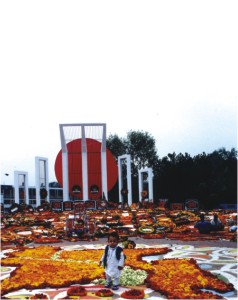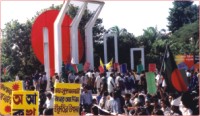Feature
Road to Ekushey February
A Brief History of the Language Movement
Compiled by Mahmud-Ur-Rashid
 1947, September 15, 1947 1947, September 15, 1947
Tamuddun Majlis (Cultural Society, an organization by scholars, writers and journalists oriented towards Islamic ideology) in a booklet titled State Languages of Pakistan : Bengali or Urdu? demands Bengali as one of the state languages of Pakistan.
The Secretary of the Majlis, at that time a Professor of Physics in Dhaka University, (Abul Kashem) was the first person to convene a literary meeting to discuss the State Language issue in the Fazlul Huq Muslim Hall, a student residence of Dhaka University. Supporters and sympathizers soon afterwards formed a political party, the Khilafate-Rabbani Party with Abul Hasim as the Chairman.
November 1947
In Karachi, the representatives of East Bengal attending the Pakistan Educational Conference, called by the Minister of Education Fazlur Rahman, a Bengali, oppose Urdu as the only national language.
1948, February 23, 1948
Direndra Nath Dutta, a Bengali opposition member, moves a resolution in the first session of Pakistan's Constituent Assembly for recognizing Bengali as a state language along with Urdu and English.
The resolution was opposed by Liakat Ali, the Prime Minister of Pakistan and other non-Bengali members in the Assembly. Regrettably, this was opposed by Khawaja Nazimuddin - hailing from the eastern wing - and a few other Bengali collaborators of the West Pakistanis in the Assembly.
Later, D. N. Dutta came up with a few amendments to the original resolution, and every time these were opposed by the west Pakistanis and their Bengali stooges. The West Pakistanis were uncompromising to such a genuine demand of the majority Bengalis.
The demand for Bengali as one of the state languages gathered the spontaneous support of the Bengali Civil Servants, academics, students, and various groups of middle class. Several members of the Provincial Assembly, including some ministers, were reportedly active in supporting the movement. By the end of February 1948, the controversy had spilled over on the streets. The East Pakistan Student League, founded in the first week of January by Sheikh Mujibur Rahman, was in the forefront of the agitation.
March (1st week) 1948
A Committee of Action of the students of Dhaka University, representing all shades of opinion - leftists, rightists, and centrists - is set up with the objective of achieving national status of Bengali.
March 11, 1948
Students demonstrating for Bangla as state language are baton-charged and a large number of students are arrested in Dhaka.
The situation grew worse in the days that followed. The Quaid-i-Azam was due to visit Dhaka from 19 March. The provincial government became nervous and Nazimuddin under pressure of widespread agitation, the impending visit of the Governor-General, sought the help of Muhammad Ali Bogra to enter into negotiations with the Committee of Action. An agreement was signed by Nazimuddin with the Committee which, inter alia, provided that (1) the Provincial Assembly shall adopt a resolution for making Bengali the official language of East Pakistan and the medium of instruction at all stages of education; and (2) the Assembly by another resolution would recommend to the central government that Bengali should be made one of the state languages.
March 21, 1948
Mohammad Ali Jinnah, the founder of Pakistan and its first Governor-General, while on a visit to East Bengal, declares in Dhaka University convocation that while the language of the province can be Bengali, the "State language of Pakistan is going to be Urdu and no other language. Any one who tries to mislead you is really an enemy of Pakistan.”
The remark evoked an angry protest from the Bengali youth who took it as an affront: their language Bangla (Bengali) was, after all, spoken by fifty-four percent of the population of Pakistan. Sheikh Mujibur Rahman, was among those who raised the protest slogan and was placed under detention. The Dacca University campus became the focal point for student meetings in support of the Bangla language.
Jinnah meets the student representatives of Committee of Action to persuade them of the necessity of having one national language, but the students are not convinced.
The discussion of Jinnah with the student representatives could not bear any fruit but blurred the difference between the student group led by Sheikh Mujibur Rahman and his associates and the student group led by Shah Azizur Rahman. The National leadership resorted to repressive policies in order to crush the Bengali language and put its supporters behind bars.
1952, January 26, 1952
The Basic Principles Committee of the Constituent Assembly of Pakistan announces its recommendation that Urdu should be the only state language. In a public meting at Paltan Maidan, Dhaka, Prime Minister Nazimuddin declares that Urdu alone will be the state language of Pakistan. Both the developments spark off the second wave of language agitation in East Bengal.
January 28, 1952
The students of Dhaka University in a protest meeting call the Prime Minister and the Provincial Ministers as stooges of West Pakistan.
January 30, 1952
In a secret meeting called by the Awami League, which is attended by a number of communist front as well as other organizations, it is agreed that the language agitation cannot be successfully carried by the students alone. To mobilize full political and student support, it is decided that the leadership of the movement should be assumed by the Awami League under Bhashani.
January 31, 1952
Bhashani presides over an all-party convention in Dhaka. The convention is attended by prominent leaders like Abul Hashim and Hamidul Haq Choudhury. A broad-based All-Party Committee of Action (APCA) is constituted with Kazi Golam Mahboob as Convener and Maulana Bhashani as Chairman, and with two representatives from the Awami League, Students League, Youth League, Khilafate-Rabbani Party, and the Dhaka University State Language Committee of Action.
February 3, 1952
Committee of Action holds a protest meeting in Dhaka against the move 'to dominate the majority province of East Bengal linguistically and culturally'. The provincial chief of Awami League, Maulana Bhashani addresses the meeting. On the suggestion of Abul Hashim it decides to hold a general strike on 21 February, when the East Bengal Assembly is due to meet for its budget session.
February 20, 1952
At 6 p.m. an order under Section 144 of the Criminal Procedure Code prohibiting processions and meetings in Dhaka City is promulgated.
This order generated tension and resentment among the students.
 February 21, 1952 February 21, 1952
A general strike is observed.
Noon - A meeting is held in the campus of Dhaka University. Students decide to defy the official ban imposed by Nurul Amin's administration and processions are taken out to stage a demonstration in front of the Provincial Assembly. Police starts lobbing tear gas shells to the students. Students retaliate by batting bricks. The ensuing riot spreads to the nearby campuses of the Medical and Engineering colleges.
4 p.m. -The police opens fire in front of the Medical College hostel. Five persons - Mohammad Salauddin, Abdul Jabbar, Abul Barkat, Rafiquddin Ahmed and Abdus Salam - are killed; the first three are students of Dhaka University. The news of the killing spread like wildfire throughout the city and people rushed in thousands towards the Medical College premises
Inside the assembly, six opposition members press for the adjournment of the House and demand an inquiry into the incidents. But Chief Minister Nurul Amin urges the House to proceed with the planned agenda for the day. At this point all the opposition members of the Assembly walk out in protest.
February 22, 1952
Thousands of men and women throng the university, Medical College and Engineering College areas to offer prayers for the victims of the police firing.
After prayers when they go for a procession, the police open fire. The police also fire on angry mob that burned the offices of a pro-government newspaper. Four persons are killed. As the situation deteriorates, the government calls in the military to bring things under control.
Bowing to the pressure, the Chief Minister Nurul Amin moves a motion recommending to the Constituent Assembly that Bengali should be one of the state languages of Pakistan. The motion is passed unanimously.
For the first time a number of Muslim members voted in favour of the amendments moved by the opposition, which so far had consisted of the Hindu Congress members only. The split in the Muslim League became formalized when some members demanded a separate bloc from the Speaker; the Awami (Muslim) League had attained the status of an opposition parliamentary party.
February 23, 1952
A complete general strike is spontaneously observed, despite the resolution by the Provincial Assembly. The government again responds with repressive measures.
APCA decides to observe a general strike on February 25 to protest the government's actions.
The students of Medical College erect overnight a Shahid Minar (Martyr's Memorial) at the place where Barkat was shot to commemorate the supreme sacrifices of the students and general population. Shahid Minar later became the rallying symbol for the Bengalis.
February 24, 1952
The government gives full authority to the police and military to bring the situation in Dhaka back to normal within 48 hours.
During these 48 hours the police arrested almost all the student and political leaders associated with the language movement.
February 25, 1952
The Dhaka University is closed sine die.
In the face of these repressive measures, the movement lost its momentum in Dhaka. But it spread widely throughout the districts ... In addition to demands for recognition of Bengali as one of state languages of Pakistan, students now began to call for the resignation of the Nurul Amin cabinet ... Nurul Amin claimed that the government "had saved the province from disaster and chaos" by its repressive measures. The students, however, argued that they had already "written the success story of the movement on the streets with their blood." In retrospect, whatever the merits of government and student actions, it is clear that the movement did sow the seeds of a secular-linguistic Bengali nationalism in East Bengal. Its immediate impact was to prepare the ground for the complete routing of the Muslim League in the 1954 elections by a United Front of opposition political parties, on a nationalistic plank of cultural, political and economic autonomy for East Bengal.
The Language Movement added a new dimension to politics in Pakistan. It left deep impression on the minds of the younger generation of Bengalis and imbued them with the spirit of Bengali nationalism. The passion of Bengali nationalism which was aroused by the Language Movement shall kindle in the hearts of the Bengalis forever ... Perhaps very few people realised then that with the bloodshed in 1952 the new-born state of Pakistan had in fact started to bleed to death.
(mahmud2saber@yahoo.com)
Source: Banglapedia, Wikipedia, Internet
| 